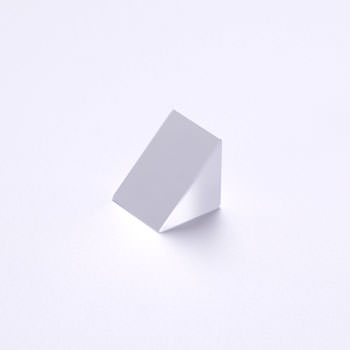OPTICAL PARTS series
光学部品 ミラー プリズム プリズムミラー
アルミ平面ミラー
硝子平面基板の片面にアルミを反射膜コーティングしミラーとしたベーシックなミラーです。 角形、丸形の他、変形四角形、楕円、穴開け、段付きなどの形状が可能です。

| コート | アルミ+SiO(保護膜) |
|---|---|
| 反射率 | 45°入射85%以上(可視域) |
| 面精度 | λ(有効エリア80%) |
| 平行度 | 3分以内 |
| 寸法公差 | 外径+0/−0.2 板厚±0.15 |
| 材質 | 白板 |
| 型式 | 大きさ | 厚さ |
|---|---|---|
| (mm) | (mm) | |
| AM-5 | 5×5 | 1 |
| AM-10 | 10×10 | 1 |
| AM-30 | 30×30 | 2 |
| AM-50 | 50×50 | 3 |
| AM-100 | 100×100 | 3 |
直角プリズム
反射膜をコーティングしていないタイプです。直角面に垂直に入射した光源は、斜面にて全反射してもう一方の直角面から射出します。 材質がS-BSL7の場合、斜面への光線の入射角41°以上で全反射が生じます。 材質、サイズの変更、コーティングの追加が可能です。

| 面精度 | λ/2 |
|---|---|
| 角度公差 | 5分以内 |
| 寸法公差 | A,B ±0.2 C +0.1/-0.3 |
| 材質 | S-BSL7 |
| 型式 | サイズ |
|---|---|
| (mm) | |
| P-5 | 5×5×5 |
| P-10 | 10×10×10 |
| P-15 | 15×15×15 |
| P-20 | 20×20×20 |
| P-25 | 25×25×25 |
直角プリズム 一面(斜面)ミラー
直角プリズムの斜面にアルミの反射膜をコーティングしたタイプです。斜面での表面反射及び入射角に幅があり
斜面での全反射が起きない場合の内面反射に使われます。材質、サイズの変更、コーティングの変更と追加が可能です。

| コート | アルミ+SiO(保護膜) |
|---|---|
| 反射率 | 45°入射において85%以上(可視域) |
| 面精度 | λ / 2 |
| 角度公差 | 5分以内 |
| 寸法公差 | A,B ±0.2 C +0.1/−0.3 |
| 材質 | S-BSL7 |
| 型式 | 大きさ |
|---|---|
| (mm) | |
| PM1-5 | 5×5×5 |
| PM1-10 | 10×10×10 |
| PM1-15 | 15×15×15 |
| PM1-20 | 20×20×20 |
| PM1-25 | 25×25×25 |
直角プリズム 二面ミラー
直角プリズムの2つの直角面にアルミの反射膜をコーティングしたタイプです。光路の表面反射での左右方向への分割、 内面反射での180°折り返しなどに使われます。材質、サイズの変更、コーティングの変更と追加が可能です。

| コート | アルミ+SiO(保護膜) |
|---|---|
| 反射率 | 45°入射において85%以上(可視域) |
| 面精度 | λ / 2 |
| 角度公差 | 5分以内 |
| 寸法公差 | A,B ±0.2 C +0.1/−0.3 |
| 材質 | S-BSL7 |
| 型式 | 大きさ |
|---|---|
| (mm) | |
| PM2-5 | 5×5×5 |
| PM2-10 | 10×10×10 |
| PM2-15 | 15×15×15 |
| PM2-20 | 20×20×20 |
| PM2-25 | 25×25×25 |
ビームスプリッター
直角プリズム2個を斜面で貼り合わせたタイプです。斜面には半透膜がコーティングしてあり、 光路の分岐、合成に使われます。材質、サイズ、透過反射特性の変更が可能です。

| コート | 誘電体多層膜 R:T=50:50 |
|---|---|
| 面精度 | λ / 2 |
| 角度公差 | 5分以内 4面ARマルチコート |
| 寸法公差 | A・B・C(共通)+0.1/-0.3 |
| 型式 | 大きさ |
|---|---|
| (mm) | |
| BS-10 | 10×10×10 |
| BS-15 | 15×15×15 |
| BS-20 | 20×20×20 |
| BS-25 | 25×25×25 |
ハーフミラー
ガラス平面基板の片側に半透膜、片側に反射防止(AR)膜をコーティングしたタイプです。光路の分岐・合成に使われます。 半透膜には誘電体多層膜タイプと金属膜タイプがございます。材質、サイズ、透過反射特性の変更が可能です。
| コート | 誘電体多層膜または金属膜 |
|---|---|
| 面精度 | λ(有効エリア80%) |
| 平行度 | 3分以内 |
| 寸法公差 | 外径+0/−0.2 板厚±0.15 |
| 材質 | 白板 |
| 誘電体多層膜タイプ | ||
|---|---|---|
| 型式 | 大きさ | 厚さ |
| (mm) | (mm) | |
| HY-1-30 | 30×30 | 1 |
| HY-1-50 | 50×50 | 1 |
| HY-1-100 | 100×100 | 1 |
| HY-2-30 | 30×30 | 2 |
| HY-2-50 | 50×50 | 2 |
| HY-2-100 | 100×100 | 2 |
| 金属膜タイプ | ||
|---|---|---|
| 型式 | 大きさ | 厚さ |
| (mm) | (mm) | |
| HI-1-30 | 30×30 | 1 |
| HI-1-50 | 50×50 | 1 |
| HI-1-100 | 100×100 | 1 |
| HI-2-30 | 30×30 | 2 |
| HI-2-50 | 50×50 | 2 |
| HI-2-100 | 100×100 | 2 |
ガラスウインド

| 面精度 | λ(有効エリア80%) |
|---|---|
| 平行度 | 3分以内 |
| 寸法公差 | 外径+0/-0.1 板厚±0.15 |
| 材質 | クラウン |
| 型式 | 大きさ | 厚さ |
|---|---|---|
| (mm) | (t) | |
| GW-10 | φ10 | 2 |
| GW-20 | φ20 | 2 |
| GW-30 | φ30 | 2 |
| GW-40 | φ40 | 2 |
| GW-50 | φ50 | 2 |
- ※厚さ(t)=1mmもあります。
拡散板
研磨剤により表面を荒らし照明などの拡散効果やピントガラスなどに使われます。 角形・丸形の他、変形四角形・楕円・穴開け・段付きなどが可能です。 研磨剤の種類を変えることにより拡散度合いを変えられます。片面拡散・両面拡散の2種類があります。
| 面精度 | λ(有効エリア80%) 母材の精度 |
|---|---|
| 平行度 | 3分以内 |
| 寸法公差 | 外径 +0/−0.1 板厚 ±0.15 |
| 材質 | クラウン |
| 片面拡散 | ||
|---|---|---|
| 型式 | サイズ | 厚さ |
| (mm) | (mm) | |
| KS-10 | φ10 | 2 |
| KS-20 | φ20 | 2 |
| KS-30 | φ30 | 2 |
| KS-40 | φ40 | 2 |
| KS-50 | φ50 | 2 |
| 両面拡散 | ||
|---|---|---|
| 型式 | サイズ | 厚さ |
| (mm) | (mm) | |
| WS-10 | φ10 | 2 |
| WS-20 | φ20 | 2 |
| WS-30 | φ30 | 2 |
| WS-40 | φ40 | 2 |
| WS-50 | φ50 | 2 |
偏光素子
入出射光の偏光特性に影響を与える光学素子です。

| 構造 | 各機能のフィルムを光学研磨されたガラスでサンドイッチし接合 |
|---|---|
| 面精度 | λ(有効エリア80%) |
| 寸法公差 | 外径 +0.1/-0.2 板厚 ±0.3 |
| ARコート | なし |
| 材質 | クラウン |
・偏光板 自然光などのランダムな振動面の光から直線偏光のみを通過させます。
・1/4波長板 直線偏光の光を光軸に対し45°の角度で入射させると円偏光の光として出射されます。
・1/2波長板 直線偏光の光を光軸に対しθの角度で入射させると 2θ分回転し出射されます。この角度は連続して維持されるので、1/2波長板を回転させると出射の偏光の向きを連続して回転させることができます。
| 型式 | サイズ | 厚さ | 種類 |
|---|---|---|---|
| (mm) | (mm) | ||
| PO-10 | φ10 | 2.5 | 偏光板 |
| PO-20 | φ20 | 2.5 | 偏光板 |
| PO-30 | φ30 | 2.5 | 偏光板 |
| PO-50 | φ50 | 3 | 偏光板 |
| RE4-10 | φ10 | 4 | 1/4波長板 |
| RE4-20 | φ20 | 4 | 1/4波長板 |
| RE4-30 | φ30 | 4 | 1/4波長板 |
| RE2-10 | φ10 | 4 | 1/2波長板 |
| RE2-20 | φ20 | 4 | 1/2波長板 |
| RE2-30 | φ30 | 4 | 1/2波長板 |

当社の総合レンズカタログを無料で配送します。
テレセントリックレンズ、マクロレンズ、CCTVレンズをはじめとしたマシンビジョン、FA用途に適したレンズが豊富です。技術者必須の図面を全機種掲載し、お手元に一冊あると便利なカタログとなっています。オプトエンジニアリング社の最新カタログも配送します。(PDF版もあります)
カタログダウンロード / 発送依頼
Opto Engineering(オプトエンジニアリング)社はイタリアに本拠を置く光学系レンズメーカーです。当社オプトアートは日本国内の販売代理店です。
※海外製品のため為替変動により毎月価格の見直しを行っています。
